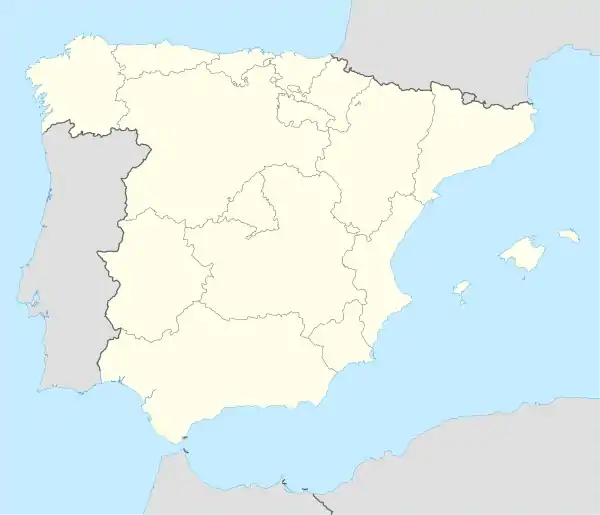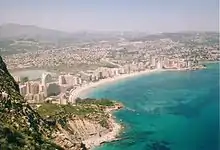Costa Blanca
The Costa Blanca (Valencian: [ˈkɔsta ˈβlaŋka], Spanish: [ˈkosta ˈβlaŋka], literally meaning "White Coast") is over 200 kilometres (120 mi) of Mediterranean coastline in the Alicante province, on the southeastern coast of Spain. It extends from the town of Dénia in the north, beyond which lies the Costa del Azahar (or Costa dels Tarongers), to Pilar de la Horadada in the south, beyond which lies the Costa Cálida.


The name Costa Blanca was coined in the 1950s as a way to promote tourism.[1][2] The region has a well-developed tourism industry and is a popular destination for British and German tourists.
The localities along the Costa Blanca are Alicante (Alicante/Alacant), Altea, Benidorm, Benissa (Benisa), Calp (Calpe), Dénia (Denia), Elche (Elche/Elx), El Campello (Campello), Finestrat, Guardamar del Segura, L'Alfàs del Pi (Alfaz del Pi), Orihuela Costa, Pilar de la Horadada, Santa Pola, Teulada–Moraira, Torrevieja, Villajoyosa (Villajoyosa/La Vila Joiosa) and Xàbia (Xàbia/Jávea). Benidorm and Alicante are the major tourist centres.
History and politics
The Iberians were the oldest documented people living in what today is the Alicante province. Belonging to these there are several archaeologic sites from which is specially known the one in La Serreta (near Alcoy) because the longest inscriptions remaining in the undeciphered Iberian language were found there. Along the coast and contemporarily to the Iberians, the seafaring Phoenicians (in Guardamar) and Greeks (along the coastal section to the north of the Alicante city) settled stable trading colonies and interacted with the former (see Lady of Elche for the most renowned archeological piece of this period). After a brief Carthaginian period, the Romans took over. Romanization in this part of Iberia was intense, the Via Augusta communicated this part of the Empire to the metropoli and so several cities thrived, from which the one known as Ilici Augusta (now Elche) even reached the status of colonia. After a brief period of Visigothic ruling, the area was taken by Islamic armies and became a part of Al Andalus. From the 13th century, kings like Ferdinand III of Castile, James I of Aragon, Alfonso X of Castile, James II of Aragon reconquered the cities that Moors occupied. What today is the Alicante province was initially split between the Crown of Castile and the Crown of Aragon by means of the Treaty of Almizra, however later on the whole territory became under the control of the Kingdom of Valencia, which was a component Kingdom of the Crown of Aragon. Alicante contributes with 12 deputies in the Spanish Parliament and with 36 deputies in the Corts Valencianes, the regional Parliament of the Valencian Community.
Climbing
Costa Blanca is a popular climbing location thanks to its limestone crags and good weather conditions.[3][4]
References
- Breuer, Toni (1982): Spanien. 1st ed., p. 213.
- Fründt, Hans-Jürgen (2009): Costa Blanca. 4th ed., p. 77.
- "Costa Blanca - Spain's Premier Winter Sun Destination". Archived from the original on Jun 20, 2019.
- "Rock Climbing in Costa Blanca". Archived from the original on Nov 23, 2018.
External links
| Wikimedia Commons has media related to Costa Blanca. |
| Wikivoyage has a travel guide for Costa Blanca. |
- Costa Blanca Tourism, official website by the Diputación Provincial de Alicante
- Information about Costa Blanca, official website for Tourism in Spain
- Landscapes of the Costa Blanca, photo gallery
